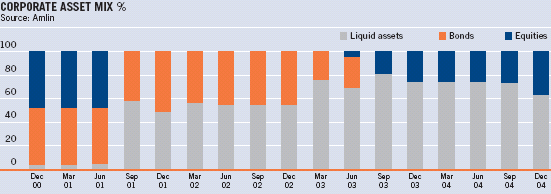|
|
|
|
|
 |
OPERATING AND FINANCIAL REVIEW / THE COMPANY / DELIVERING VALUE /

 |
| CORPORATE ASSETS |
 |
For the corporate assets we do not have a
liability benchmark. These assets represent the
long term capital of the Group which acts as
solvency capital for our underwriting operations.
Therefore, a longer term view can be taken
when making asset allocation decisions.
To determine the optimal strategic asset
allocation we use data provided by Watson
Wyatt from which we establish the most
efficient portfolio mix for our current risk
appetite (VaR1).
Our risk appetite will change over the
underwriting cycle. The below chart shows
recent changes to the corporate funds asset
mix, with equities being sold post 9/11
as the underwriting market hardened. Although
the risk appetite remained low, equities were
reintroduced during 2003 because we believed
the asset class offered superior returns to bonds.
Bonds were judged to be expensive, and to
compensate for the volatility of equities, as
indicated by our VaR modelling, cash made
up the rest of the assets.

As we move into softer underwriting conditions
our investment risk appetite is again increasing.
In November 2004 we revised the benchmark
equity content of our corporate portfolio to
50%, from 25%, although to date we have
only invested 33% in this class.
To improve the returns available for our given
level of risk, we intend to explore the benefits
of further asset diversification.
|
 |
| EXCHANGE MANAGEMENT |
 |
We have continued to actively manage the
exchange risks associated with earning profits
in foreign currencies.
This risk is mitigated through a policy of
converting foreign currency profits to sterling as
insurance risk expires. Given the inherent
volatility of some of our business a cautious
approach is adopted on the speed and level of
sales, but we seek to extinguish currency risk
on earned profit during the second year after
the commencement of an underwriting year.
During 2004, US$282 million of profits were
sold at an average rate of US$1.82: £1
compared with a year end rate of US$1.92: £1.
These sales also enabled us to achieve an
investment yield pick up given the differential
between dollar bond yields and sterling.
1 Value at risk (VaR) is a technique which uses the statistical analysis
of market returns, correlations and volatilities to estimate the likelihood
that a given portfolio’s losses will exceed a certain amount.
|
|
|
|
|

|
  |
|
|
|
|